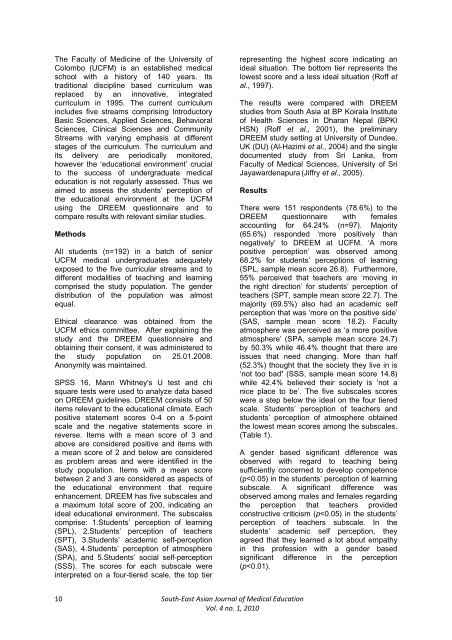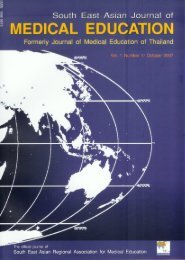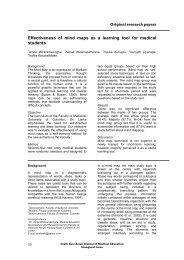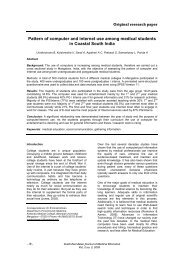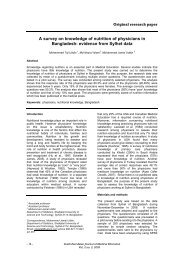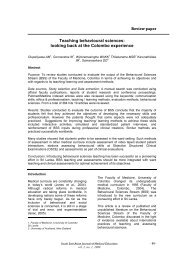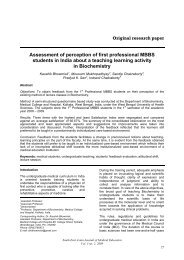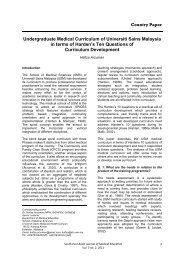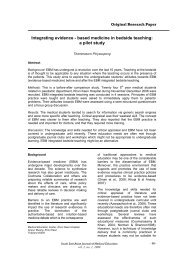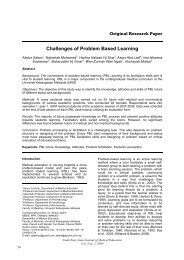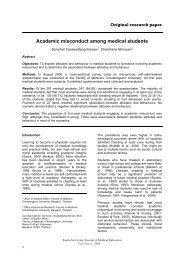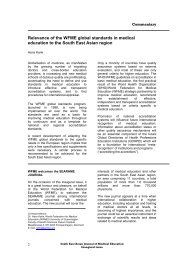Students' perception of the educational environment in a Medical ...
Students' perception of the educational environment in a Medical ...
Students' perception of the educational environment in a Medical ...
Create successful ePaper yourself
Turn your PDF publications into a flip-book with our unique Google optimized e-Paper software.
The Faculty <strong>of</strong> Medic<strong>in</strong>e <strong>of</strong> <strong>the</strong> University <strong>of</strong><br />
Colombo (UCFM) is an established medical<br />
school with a history <strong>of</strong> 140 years. Its<br />
traditional discipl<strong>in</strong>e based curriculum was<br />
replaced by an <strong>in</strong>novative, <strong>in</strong>tegrated<br />
curriculum <strong>in</strong> 1995. The current curriculum<br />
<strong>in</strong>cludes five streams compris<strong>in</strong>g Introductory<br />
Basic Sciences, Applied Sciences, Behavioral<br />
Sciences, Cl<strong>in</strong>ical Sciences and Community<br />
Streams with vary<strong>in</strong>g emphasis at different<br />
stages <strong>of</strong> <strong>the</strong> curriculum. The curriculum and<br />
its delivery are periodically monitored,<br />
however <strong>the</strong> ‘<strong>educational</strong> <strong>environment</strong>’ crucial<br />
to <strong>the</strong> success <strong>of</strong> undergraduate medical<br />
education is not regularly assessed. Thus we<br />
aimed to assess <strong>the</strong> students’ <strong>perception</strong> <strong>of</strong><br />
<strong>the</strong> <strong>educational</strong> <strong>environment</strong> at <strong>the</strong> UCFM<br />
us<strong>in</strong>g <strong>the</strong> DREEM questionnaire and to<br />
compare results with relevant similar studies.<br />
Methods<br />
All students (n=192) <strong>in</strong> a batch <strong>of</strong> senior<br />
UCFM medical undergraduates adequately<br />
exposed to <strong>the</strong> five curricular streams and to<br />
different modalities <strong>of</strong> teach<strong>in</strong>g and learn<strong>in</strong>g<br />
comprised <strong>the</strong> study population. The gender<br />
distribution <strong>of</strong> <strong>the</strong> population was almost<br />
equal.<br />
Ethical clearance was obta<strong>in</strong>ed from <strong>the</strong><br />
UCFM ethics committee. After expla<strong>in</strong><strong>in</strong>g <strong>the</strong><br />
study and <strong>the</strong> DREEM questionnaire and<br />
obta<strong>in</strong><strong>in</strong>g <strong>the</strong>ir consent, it was adm<strong>in</strong>istered to<br />
<strong>the</strong> study population on 25.01.2008.<br />
Anonymity was ma<strong>in</strong>ta<strong>in</strong>ed.<br />
SPSS 16, Mann Whitney's U test and chi<br />
square tests were used to analyze data based<br />
on DREEM guidel<strong>in</strong>es. DREEM consists <strong>of</strong> 50<br />
items relevant to <strong>the</strong> <strong>educational</strong> climate. Each<br />
positive statement scores 0-4 on a 5-po<strong>in</strong>t<br />
scale and <strong>the</strong> negative statements score <strong>in</strong><br />
reverse. Items with a mean score <strong>of</strong> 3 and<br />
above are considered positive and items with<br />
a mean score <strong>of</strong> 2 and below are considered<br />
as problem areas and were identified <strong>in</strong> <strong>the</strong><br />
study population. Items with a mean score<br />
between 2 and 3 are considered as aspects <strong>of</strong><br />
<strong>the</strong> <strong>educational</strong> <strong>environment</strong> that require<br />
enhancement. DREEM has five subscales and<br />
a maximum total score <strong>of</strong> 200, <strong>in</strong>dicat<strong>in</strong>g an<br />
ideal <strong>educational</strong> <strong>environment</strong>. The subscales<br />
comprise: 1.Students’ <strong>perception</strong> <strong>of</strong> learn<strong>in</strong>g<br />
(SPL), 2.Students’ <strong>perception</strong> <strong>of</strong> teachers<br />
(SPT), 3.Students’ academic self-<strong>perception</strong><br />
(SAS), 4.Students’ <strong>perception</strong> <strong>of</strong> atmosphere<br />
(SPA), and 5.Students’ social self-<strong>perception</strong><br />
(SSS). The scores for each subscale were<br />
<strong>in</strong>terpreted on a four-tiered scale, <strong>the</strong> top tier<br />
represent<strong>in</strong>g <strong>the</strong> highest score <strong>in</strong>dicat<strong>in</strong>g an<br />
ideal situation. The bottom tier represents <strong>the</strong><br />
lowest score and a less ideal situation (R<strong>of</strong>f et<br />
al., 1997).<br />
The results were compared with DREEM<br />
studies from South Asia at BP Koirala Institute<br />
<strong>of</strong> Health Sciences <strong>in</strong> Dharan Nepal (BPKI<br />
HSN) (R<strong>of</strong>f et al., 2001), <strong>the</strong> prelim<strong>in</strong>ary<br />
DREEM study sett<strong>in</strong>g at University <strong>of</strong> Dundee,<br />
UK (DU) (Al-Hazimi et al., 2004) and <strong>the</strong> s<strong>in</strong>gle<br />
documented study from Sri Lanka, from<br />
Faculty <strong>of</strong> <strong>Medical</strong> Sciences, University <strong>of</strong> Sri<br />
Jayawardenapura (Jiffry et al., 2005).<br />
Results<br />
There were 151 respondents (78.6%) to <strong>the</strong><br />
DREEM questionnaire with females<br />
account<strong>in</strong>g for 64.24% (n=97). Majority<br />
(65.6%) responded ‘more positively than<br />
negatively’ to DREEM at UCFM. ‘A more<br />
positive <strong>perception</strong>’ was observed among<br />
68.2% for students’ <strong>perception</strong>s <strong>of</strong> learn<strong>in</strong>g<br />
(SPL, sample mean score 26.8). Fur<strong>the</strong>rmore,<br />
55% perceived that teachers are ‘mov<strong>in</strong>g <strong>in</strong><br />
<strong>the</strong> right direction’ for students’ <strong>perception</strong> <strong>of</strong><br />
teachers (SPT, sample mean score 22.7). The<br />
majority (69.5%) also had an academic self<br />
<strong>perception</strong> that was ‘more on <strong>the</strong> positive side’<br />
(SAS, sample mean score 18.2). Faculty<br />
atmosphere was perceived as ‘a more positive<br />
atmosphere’ (SPA, sample mean score 24.7)<br />
by 50.3% while 46.4% thought that <strong>the</strong>re are<br />
issues that need chang<strong>in</strong>g. More than half<br />
(52.3%) thought that <strong>the</strong> society <strong>the</strong>y live <strong>in</strong> is<br />
‘not too bad’ (SSS, sample mean score 14.8)<br />
while 42.4% believed <strong>the</strong>ir society is ‘not a<br />
nice place to be’. The five subscales scores<br />
were a step below <strong>the</strong> ideal on <strong>the</strong> four tiered<br />
scale. Students’ <strong>perception</strong> <strong>of</strong> teachers and<br />
students’ <strong>perception</strong> <strong>of</strong> atmosphere obta<strong>in</strong>ed<br />
<strong>the</strong> lowest mean scores among <strong>the</strong> subscales.<br />
(Table 1).<br />
A gender based significant difference was<br />
observed with regard to teach<strong>in</strong>g be<strong>in</strong>g<br />
sufficiently concerned to develop competence<br />
(p


